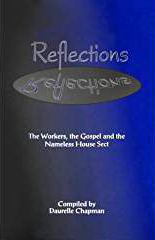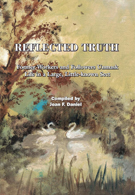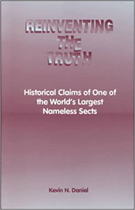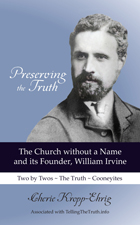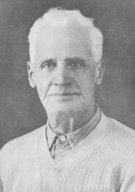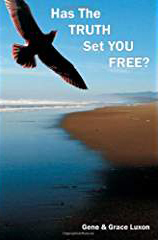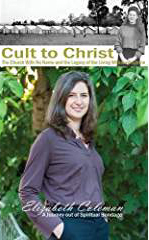Early Workers
Edward Cooney's Relatives
Revised May 20, 2018
Mary Elizabeth (Cooney) Boyton Smith, sister
Alfred Carson Cooney's Will, brother
William Rutherford Cooney, father
Elliott, Tom & Ellen
Mary Elizabeth (Cooney) Boyton Smith
( Sister of Edward Cooney )
February 16, 1866 - March 22, 1953
Click Here to View her Photo
Memories of My Great Uncle, Edward Cooney
by Helena Halpin
(1925-2015)
My Grandmother, Mary Elizabeth, was born February 16, 1866 and on September 9, 1896 she married *Sydney Boyton Smith who was born September 21, 1865. He was an Episcopalian Rector in Bondleigh, West Devon, England.** Edward Cooney was my Grandmother’s brother, which made him my Great Uncle. My (maternal) Grandmother spoke fondly about her brother Edward. She loved him and his work and agreed with Edward’s way of living. They were a very musical family and my mother, her brother Edward and their father (the Rector) often entertained the local people with musical evenings in various village halls.
I am not sure when Gans (her grandchildren called her Gans) started to follow Edward's religion, but I think she was very dissatisfied with her husband's church. She said that while she was the Rector's wife she had to do all the wifely duties in the parish, and in the home, as well, of course. I think she was dismayed by what she called "dressing up and play-acting," so I guess it must have been a rather "high" church of England. I am told that as long as her husband was alive, she performed all the usual Rector's wife's duties. (See Photo of Mary Elizabeth Smith)
Gans was offered financial help from the Church when her husband died June 27, 1923, which was a year or two before my parents were married. She refused it because she felt it would be an immoral thing to do, in view of the way she felt about the Church. Although my Mum and her younger sister and brother were still in her care, Gans moved to a cottage in Newton Poppleford and trusted God to provide.*** Newton, Poppleford is a little place a few miles east of Exeter in Devonshire. Gans and Edward's father died (William R. Cooney) in September, 1924, and her mother died in December, 1917.**** My mother spoke of visiting her grandparents as a girl.
Gans never returned to an organised Church. Often little groups of her friends worshipped in her home. I was only about 5-8 years old in those days and had to be quiet for what seemed like hours! I didn't take part in these meetings. Gans played the piano beautifully and I remember that we sang hymns and old folk songs and some made-up songs too.
Gans knew a lady named Ellen Elliott***** who used to come from time to time and stay with her. She was the widow of the late Thomas Elliott. As a young child I remember asking Mrs. Elliott where she lived. She told me that she lived wherever she was needed. She had only a very small suitcase and that puzzled me. I asked, "But where are all your things?" She said that except for what was in her case, everything was provided for her as she travelled about. I was very fond of Mrs. Elliott, and when I visited Gans, I was glad if Mrs. Elliott happened to be there at the time. Mrs. Elliott must have visited some time in the 1930's I think. She might have come in the 1940's also, but that would have been during the war and people travelled very little then. I do not know where she came from. (See Photo of Elliotts) Story of Tom & Ellen Elliott
I met my Great Uncle Edward twice when he stayed with Gans in Clevedon, Somerset. I was in my teens, and I took an instant liking to him, even though I only saw him briefly. He was interested in my life and quite uncritical. As children, my brother and I collected stamps for him. Why--I canít remember!
According to Patricia Roberts, Uncle Edward preached in the U.K., USA, Canada Australia and New Zealand. As I remember it, we knew that he travelled all over the place, though we never asked about specific places. I wish I had been more interested at the time when there were people to ask. Alas, now they are all gone.
My husband Rick and I now live in Duncan on Vancouver Island, having come to Canada in1954. We are approaching our 60th anniversary in February, 2009 and I couldn't have wished for a better mate. We have 2 sons, one adopted and one homemade, Mark and Chris, who are now 50 and 51, both are fine fellows and both have 2 children apiece.
My parents came to join us in Duncan when they were in their 70ís and 80ís. My father was a solid Anglican and went to St, Johns here. Mum had been looking for a small group to join when a neighbour suggested that she might enjoy the services she went to. So, off they went and Mum remarked that they bore some resemblance to a group her uncle started. When the neighbour heard his name, she was amazed. "This is the same group," she said. So mum went to their services, and sometimes Dad or I joined her, but not very often. She seemed happy although she refused to be baptised. She just didn't want to make that commitment. We all liked the people and went to some of their social events and felt quite at ease. Though she had been baptized as an infant, they pressured her to be baptised when Mum was nearing the end of her life here. But she told me that she felt that they were not really Uncle Edward's people, though very kind but "not quite right." As far as I know, Mum was baptised in the Church of England.
I go to our local Anglican church, and sometimes Rick comes with me, or he did before he became so ill. It is a warm and caring church and the people are wonderful. They are a great support to both of us. The Cowichan valley is an old established area, mostly rural with Duncan as the central town (population about 5,000) Many of the people are descendants of the original settlers.
By Helena Mary (Baker) Halpin
83 years old in 2008
Mary Elizabeth (Cooney) Boyton Smith died March 22, 1953 in Cambridge, England.
*Mary Elizabeth, married Rev. S. Boyton-Smith of Holy Trinity Church, Norwich, 9 September 1896 at Rossorry Parish Church. They were a musical couple, Mary was regarded as the best piano accompanist of her day, while her husband played the cello. Before he took holy orders he had been an assistant master at Portora.
**Wikipedia: Bondleigh is a village and civil parish in the West Devon district of Devon, England, on the River Taw, north of North Tawton. According to the 2001 census it had a population of 123. The church, though 15th century, has traces of a norman window above the chancel, as well as other Norman features: carved stones in the walls, the baptismal font and a tympanum. There are old bench-ends, and 15th century glass. In the churchyard is the shaft of its ancient cross, possibly once a megalith.
***Mary Elizabeth was left a legacy by her brother Alfred Cooney who died in 1909. See his will below.
**** Mary Elizabeth's father (William R. Cooney) died on September 12, 1924, and he left to her, her sister and two married brothers approximately one-fourth each of his estate. His wife, Emily Maria (Carson) Cooney had passed away previously on December 18, 1917.
*****Tom Elliott was married to Ellen Elliott and they went in the work in 1902. Patricia Roberts wote: "As well as restoring the scriptural methods of preaching and worshipping, the Go Preachers also sought to restore the scriptural method of baptism....so Tom Elliott was unanimously chosen, and all agreed that the choice was a good one. He it was who baptized all the early preachers and converts... He was a man in about his mid thirties who had been a prosperous farmer and who with his wife Ellen enjoyed a comfortable home and happy settled way of life. They had no children... They too heard the call to forsake all and follow Jesus. So in 1902 they obeyed the call just two years after they were married. Tom sold his farm and all his earthly possessions, gave the proceeds to the poor, and with his wife, Ellen, took up his cross and went also to preach the gospel of faith in fellowship with other Go Preachers." (The Go-Preacher Movement an Anthology compiled by Patricia Roberts, pp 54-56) The Elliotts sided with Ed Cooney and left the sect in the 1928 Division.
Mr. & Mrs. Elliott were faithful loyal followers of Edward Cooney up until their deaths.
Tom was called "Tom the Baptist," and he had baptized ten of the workers who excommunicated he and Ed Cooney.
Tom died in 1930 at Mrs. Hick's home, Mount Hill, Kingswood, Bristol, England in 1930. He was buried in a borrowed grave at Holy Trinity churchyard, Kingswood, Bristol. Ellen died April 16, 1966 and was buried in the same grave as Tom. After Tom's death, Ellen continued in the 'work' until she died. Both passed away in England. The pair are shown on the 1921 Staffordshire Worker Convention photograph as Nos. 16, 168. See photo. Read story of Tom and Ellen Elliott
August 5, 1909, p. 8
THE IMPARTIAL REPORTER
Established 1808
Newspaper for Enniskillen, Northern Ireland
He had an half hour's talk with his brother-in-law, Rev. Boyton Smith, B.A. who wanted to convert him (Mr. Cooney), but he (Cooney) told Mr. Smith that he himself was not converted yet. He (Cooney) told Mr. Smith his doctrine, and when he had finished, Smith said merely ‘Fiddlesticks;’ and his (Mr. Cooney’s) explanation of that reply being that Smith had no argument.
August 5, 1909, p. 8
THE IMPARTIAL REPORTER
Established 1808
Newspaper for Enniskillen, Northern Ireland
MY BROTHER IN-LAW the Rev. Sydney Upton Smith, M.A., [TTT Editors NOTE: name should be "Boyton" not "Upton"] Vicar of St. Clements, Bristol, is a clergyman. I saw him a few months ago when I called on him and my sister. I had a talk with him and he did not begin going into preliminaries with me, as he knew my history and life and testimony. He began telling me of some people that were getting converted through his preaching in Bristol.
I said to him, ‘You want to be converted yourself.’ (Laughter.) He began then pointing out to me the different other things., I proceeded to tell him that unless he joined the Jesus way he would be lost for ever and all he could say was ‘fiddlesticks’—(laughter); and the reason he said this was because he had not been left a leg to stand on, and that's all he could say and I never yet met a clergyman who had a leg to stand on.’ The reason why they keep so quiet while we speak is because if they open their mouth they will get deeper into the ‘bog.’ ‘Until you cease standing by the clergyman,’ the speaker continued, ‘I cannot offer you any hope of you ever being saved.’
NOTE: View picture of St. Clements Church in Bristol England
"St Clement's church was a large church on the corner of Houlton Street and Newfoundland Road. The foundation stone was laid on May 24th 1854, the church opened in 1855. The tower at the SW corner was never completed but the spirelet reached a height of 65 feet. The architects were S.B.Gabriel and J.H.Hirst.
"It all came to an end during the Second World War. In the words of the then vicar Rev. G.R. Fooks 'the actual destruction of St Clement was not during a Bristol blitz, but on the Wednesday before the Good Friday blitz of 1941, when one odd plane dropped stuff causing a fire in Broadmead. The next Jerry to come over got his line on that fire but missed by nearly 500 yards - and got us! Nothing else fell in Bristol that night, 9th/10th April.' "
Newspaper clipping (no date)
$500 a Year to Stop Preaching
DUBLIN, Dec. 12 (probably 1924) Ė A novel bequest and ban on preaching appears in the will of Mr. William Rutherford Cooney of 15 Willoughbyplace, Enniskillen, who left £8,915.
He directs that in the event his son Edward stating in writing that he has ceased to preach and has returned to allegiance to the Church of Ireland, thereby abandoning his means of living, £100 per annum shall be paid to him so long as he adheres faithfully to his decision.

Source: Public Record Office of Northern Ireland aka PRONI
William Rutherford Cooney
Date of Death: 12 September 1924
Date of Grant: 31 October 1925
Effects: £4969 7s 10d
Registry: Londonderry
Full Abstract: Cooney, William Rutherford of 15 Willoughby Place Enniskillen county Fermanagh justice of the peace died 12 September 1924 Probate Londonderry 31 October to the reverend Hubert MacManaway clerk the reverend canon Isaac H. Pratt clerk and James McConnell bank manager. Effects £4969 7s 10d
Excerpt from W. R. Cooney's will: "In the event of my son Edward Cooney stating in writing to my said executers and trustees that he the said Edward Cooney has ceased preaching and also that he has returned to allegiance to the Church of Ireland thereby abandoning his means of living I leave devise and bequeath to my said son Edward Cooney an annuity of one hundred pounds per annum payable quarterly as a first charge out of said trust fund so long as the said Edward Cooney adheres faithfully to his decision."
June 23, 1960
THE IMPARTIAL REPORTER
Established 1808
Newspaper for Enniskillen, Northern Ireland
.
EDWARD COONEY
A GREAT FIGURE PASSES
One of Enniskillen’s most remarkable men, Edward Cooney, who turned his back on wealth to become a wandering preacher and the founder of a new religious sect, the Cooneyites, has died in Australia at the age of 93.
The second son of Mr. William Rutherford Cooney, who owned an extensive drapery business in High Street, Enniskillen, and who resided at Lakeview, Edward Cooney was a commercial traveller for his father’s business. His parents were members of the Church of Ireland and Edward was baptized and brought up in that faith, but becoming very serious minded early in life, and through diligent reading of the Scriptures, he arrived at variance with the views of the churches.
Left the Church
He then left the Church of Ireland and commenced to preach the doctrines which he believed were correct. He was persevering and combative, sometimes even violently outspoken in his attacks on the clergy and the established churches. He impressed those whom he addressed at meetings throughout Ireland, in England, the United States, and Australia with his earnestness.
SPURNED WEALTH
Edward Cooney endeavoured to follow exactly in the footsteps of Christ, and he appealed to his followers to do likewise. He spurned wealth and property and although he was left a large fortune on condition that he returned to the Church of Ireland, he resisted this temptation and never accepted a penny from the extensive Cooney Estate, which was placed in trust.
Mr. Cooney led an austere life, dividing what meagre possessions he had with those who might happen to be in poorer circumstances than himself.
Having decided to leave the Church of Ireland, he proceeded to join with and lead an ever-increasing group of followers who were given various names, ‘The Tramp Preachers,’ ‘The Pilgrims,’ ‘The Go-preachers,’ and ‘The Dippers,’ the latter name being derived from the fact that those who were received into the faith were baptized by total immersion.
THE CONVENTIONS
Great meetings, or conventions as they were called, were held between 1908-’10 at Crocknacrieve, near Ballinamallard, the home of the late Mr. John West, and crowds of several thousand people travelled to hear the speakers. The conventions lasted for weeks and elaborate arrangements were made to provide meals and to accommodate those who stayed over-night. Teams of workers looked after the cooking, the transport, the sleeping accommodation and there was even a barber’s shop. Everything was done voluntarily.
The ‘Pilgrims’ dressed sombrely, the women mostly in black, and were strictly segregated from the men. Many of the men wore beards.
ATTACKS ON CLERGY AND CHURCHES
In his addresses at the early conventions, Mr. Cooney used fiery language and was often violently critical and abusive in his attacks on the clergy and churches. He attacked both Protestant and Roman Catholic clergy and said that anyone who followed them was sure of going to hell. In later life he mellowed considerably and his addresses were more tolerant of other denominations.
Towards the end of his life Mr. Cooney spent a good deal of his time in Australia. His last visit to County Fermanagh was just over a year ago, when on a Saturday evening, seated on a chair on the Diamond in Enniskillen, with a rug around his frail figure, but still a striking character with his flowing white beard, he took part in a meeting with a group of his faithful followers.
Alfred Carson Cooney’s mysterious death
(Edward Cooney’s brother)
The Impartial Reporter
September 4, 1909 - Enniskillen Sensation.
Tragic death of Mr. A. C. Cooney, solicitor.
Found with throat cut.
Blood-stained razor beside him.
Inquest and verdict.
The Anglo-Celt (Cavan)
September 4, 1909 p. 1 -
Enniskillen Tragedy – Well Known Solicitor’s Death -
Alfred Carson Cooney
The Shoreditch Observer, Hackney Express, Bethnal Green Chronicle and Finsbury Gazette; London, England
September 4, 1909 p. 2.
The 1st paragraph article is titled "Irish Solicitor's Suicide", but this would have been written prior to any formal inquest or determination.
WILL OF ALFRED CARSON COONEY
Source: Public Record Office of Northern Ireland aka PRONI
Date of Death: 29 August 1909
Date of Grant: 15 November 1909
Effects: £6,674 9s 3d
Probate of the Will of Alfred Carson Cooney late of Enniskillen County Fermanagh Solicitor who died 29 August 1909 at Lakeview Enniskillen granted at Armagh to William Rutherford Cooney Merchant and James McConnell Bank Manager.
Cooney, Alfred Carson:
I, Alfred Carson Cooney of Lakeview, Enniskillen, do make this my last will. I appoint my father, my brother Edward and my brother in law, James McConnell to be my Executors and the Trustees of my Estate.
I have and bequeath to my Trustees all my property in Trust to pay thereout to my Father and my three brothers the sum of £200 each. Should any of the four be dead before I die, I wish their legacy to be paid to the Personal Representative of each deceased.
After providing for the above Legacies I direct my Trustees to hold the Residue in Trust for my mother and my two sisters during their lives, that is to say the yearly income is to be divided into three parts and one paid by my Trustees to each.
At the death of my mother or should she die before me, my father is to be paid her share during his life. Should my father die before my mother, upon the death of the latter her share of the income is to be equally divided between my two married brothers Henry and Frederick or in case of death their Personal representatives during the lives of my two sisters or the survivor.
Should either of my sisters die before the other or before my mother and Father her share of the income is to be paid to her Personal Representative during the lifetime of the survivor of the others.
Upon the death of all the Female Members of my fathers family, that is of my mother and my two sisters, and upon the death of my Father should he survive my mother as aforesaid, I direct my Trustees to realize the residue and hold it in Trust as to one third for my said Two married brothers if alive, or their Personal Representative if dead, share and share alike and as to the other two thirds in Trust for the Personal Representatives of my said two sisters, share and share alike.
----------Alfred Carson Cooney----------
Signed and declared by the said Testator as his last will this 13th of December 1907 in our presence who in his presence and in presence of each other have signed our names as witnesses.
John Hanna, Law Clerk, Enniskillen
Gerard B. Liddy, Law Clerk, Enniskillen
Preaching of Edward Cooney
Additional information about Edward Cooney
Story of Tom & Ellen Elliott
Additional Information about Tom & Ellen Elliotts
Photos of Cooneys
Statements by Edward Cooney in The Impartial Reporter
Statements by Edward Cooney in the 1907 Fermanagh Times
Am I therefore become your enemy, because I tell you the Truth?
Galatians 4:16
"Condemnation without Investigation is Ignorance."
Your comments, suggestions and corrections are appreciated. You are welcome to link to this website.
© Telling the Truth
|

 REPRESENTING THE LARGEST COLLECTION OF 2X2 HISTORICAL DOCUMENTS ON THE INTERNET
REPRESENTING THE LARGEST COLLECTION OF 2X2 HISTORICAL DOCUMENTS ON THE INTERNET
 Perry, Oklahoma Conv, 1942
Perry, Oklahoma Conv, 1942
